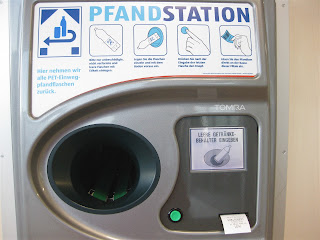Not All Trash is Equal
In the United States, there seems to be a common mentality amongst us that “all trash is equal” - meaning that we simply throw everything away into one trash can, sometimes even things that can be recycled. In terms of sustainability, this is not efficient at all and will eventually cause some future damaging effects on our environment. Simply put, our system is not suitable long-term and results in us producing more trash and filling up landfills faster than we need to. How can we change this? Luckily, Germany has a very good system for waste disposal that we can use as a model and encourage sustainability.
After staying with a guest family in Düsseldorf and living in an apartment in Weimar, I’ve learned plenty about the trash separation system that is used all throughout Germany in households and businesses (called “Mülltrennung”), with slight differences from city to city because local authorities are in charge of waste management. Instead of simply throwing everything away into one trash can (or into a trash can and one recycling bin), households in Germany separate their waste into multiple categories and have separate containers for each, allowing for proper and more efficient recycling and reuse of waste materials. At first, the system is confusing and complex, but after some time using the system, it’s become almost natural to separate all of my waste - to the point where it pains me to see someone throw a banana peel or their homework papers into the trash can. In Germany, that’s not the way to do it!
One of the separations is for paper and cardboard, which is all placed into a blue bin or bag. However, there are a couple of specifications that must be followed; cardboard and paper items that have food or contained food, like a pizza box or greasy paper plate, shouldn’t be put in there because they cause issues in the recycling process. Brown or green bins are used for biodegradable waste or waste that usually is put into a compost, including most foods, peels, etc. (called “Biomüll”). This waste is later processed in a fermentation plant. Yellow bins or bags are always used for packagings - which include plastic, aluminum, tin cans, etc. Glass gets own bin and is separated based on color: white, brown, and green. However, some glass bottles (and plastic bottles too) that are bought with a deposit (called Pfand) can be returned to bins in the grocery store, where customers will receive their deposit back. This encourages people to recycle their glass and plastic bottles, rather than throw them away (read an article on the “Pfand” system here!). Everything else left over that doesn’t fit into one of these other categories is placed into a black or grey container, known as “Restmüll.” However, hazardous waste (like batteries) should still be sorted even further and disposed of in certain drop-off locations.
With all of these categories for separation of waste, most households and businesses have multiple “trash” bins that everything is sorted into. As a foreigner in Germany, this system seems impressive and complex, but is completely normal and necessary for someone who grew up in Germany. This waste separation system in place all throughout the country is just one example of many that shows the Germany mentality and actions towards the environment and ultimately sustainability. It does require more effort, but the system is worthwhile knowing that it is one way we can make a difference in the way we control the longevity of our resources and environment.
(Image: http://www.newsmax.de/monarchis-tipps-zur-muellvermeidung-muelltrennung-und-muellverwertung--news19523.html)



Comments
Post a Comment